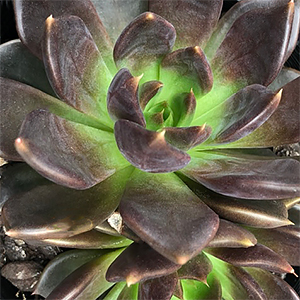
This is rosette forming Echeveria variety that will have more intense colour variation in good light. The leaves are a deep green with a purple to brown towards the leaf tips.
Echeveria ‘Black Prince’ will flower, usually in winter with small red flowers on a tall stem.
Echeveria species are regarded as non toxic to both cats and dogs.
Care
- Light
Although grown as an indoor plant it does require good light to maintain in colour. It is at its best when it can be given some time outdoors.
Indoors try growing Echeveria ‘Black Prince’ near a window, although do protect from hot afternoon sun in summer. - Growing Medium
Use a free draining soil or potting mix to ensure that it does not develop root problems. We suggest repotting every 2 – 3 years. - Watering
Watering is similar to most succulents, allow the growing medium to dry before watering. try to hold back on watering from late summer into winter as the plant goes into its dormant period. - Temperature
Echeveria generally require around 10-21°C (50 and 70°F) this is regarded as the best range.
Avoid frosts and freezes and cold windy positions. - Fertiliser
The best method of fertilising is by using a slow release fertiliser when repotting. These are not hungry plants and are best grown on the ‘lean’ side.In containers, use around 1/2 tsp of fertiliser placed in the lower 1/3 of the pot when re-potting. This encourages the roots to go deeper seeking nutrition. Each year, 1/2 teaspoon of slow release fertiliser on the surface will keep the plant in good condition until it is repotted.
- Propagation
Two methods are used, offsets and leaf cuttings.
Problems
- Over watering – this can cause fungal problems and root rot.
- Mealybug – A common problem that can be tried with Eco Oil or similar.
-
Yellow Leaves – This is usually due to, overwatering or poor drainage. The solution is to water less, allowing the soil today between watering. You mar need to re-pot in a new free draining potting mix. Also check the pot for adequate sized drainage holes.
-
Brown or dark leaves
This can be caused by too much direct sun in warmer climates. Move the plant to a position in afternoon shade.
-
Wrinkled or Shrivelled leaves
This can be caused by under watering. Water deeply and again always allow the soil to dry between waterings.
-
Soft Mushy Leaves
Again overwatering or poor drainage.
